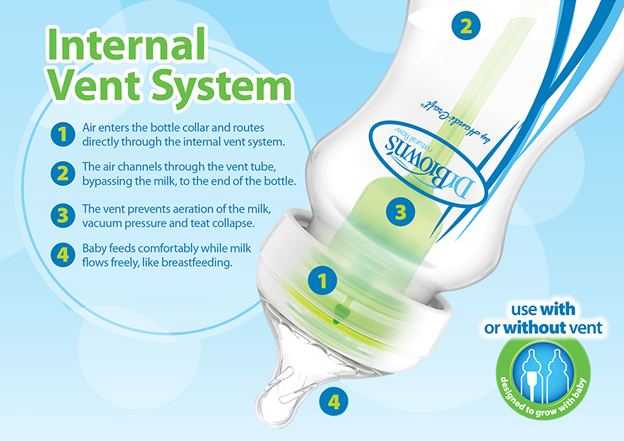Infantile Colic - Use Dr Brown's to help reduce the symptoms!
Posted by Baby-Central on 15th Sep 2020
Infantile Colic is a condition which is not easily understood, but is defined as excessive, frequent crying in a baby who appears to be otherwise healthy. It's a common problem with almost half of babies in the UK developing Colic*. While there are no long-term consequences of this condition, colic is extremely distressing for both baby and parent and long bouts can cause family tension, due to parent/carer sleep deprivation, stress, anxiety and even depression. Thankfully babies usually grow out of colic around 12 weeks of age.
There are several issues which are thought to cause colicky symptoms, but 78% of Healthcare Professionals agree that the most common cause of colic in young babies is caused by digestive or feeding problems, including swallowing air and trapped wind*. Therefore, simply preventing baby from swallowing air can be extremely beneficial in helping avoid wind related colic, such as choosing the right baby bottle.
There are many baby bottles on the market claiming to be “anti-colic”, but it is important to recognise that not all “anti-colic” bottles are the same and to understand the physics behind the bottle mechanics.
When using conventional feeding bottles, negative pressure is generated in the oral cavity as well as in the bottle when fluid is removed by sucking. The negative pressure inside the bottle causes the infant to suck excessively.
Not all vented bottles are created equal. Research shows that vacuum formed in most reusable feeding bottles, which are either non-ventilated or under-ventilated through various configurations of holes and slits in the teat rim or actual teat. The non-vented bottle is simply a solid walled vessel with a teat held in place with a cap, which does not permit any air entry, resulting in the liquid being held within the feeding vessel by the vacuum which is formed while sucking. Fluid may only be removed by the infant in small amounts by overcoming the stiffness of the wall of the teat or bottle and collapsing one or the other with a resulting small amount of liquid leaving the bottle. The high negative pressure formed at the very onset of feeding is the exact opposite of the positive pressure which occurs during physiological breast feeding.
As the teat collapses due to the negative pressure in non-vented or under-vented bottles the baby will break its seal at the teat and swallow air along with liquid into the stomach, which causes the windy colic symptoms. The collapsed teat and bubble induction into the feeding liquid are clear indications that a vacuum is present in the feeding bottle.
The under-vented feeding bottle is identical with the above closed system except that there are one or more holes or slits in the flange of the teat. This allows air to be drawn into the feeding vessel once a sufficient vacuum has formed in the bottle. The infant must first form a vacuum before air is drawn into the bottle. The negative pressure in this kind of bottle tends to form more gradually than with non-vented bottles, but still causes the baby to ingest air and potential windy colic.
In contrast a 100% fully vented bottle has an open pathway for air leading from the threads between the bottle neck and the teat collar to an internal reservior which is therefore in communication with ambient air. With fully vented bottles the initial teat pressure is positive, and the pressure remains positive throughout the entire emptying of the bottle, which ensures that the baby takes in the feed without ingesting air. This positive pressure is similar to the positive pressure present in breast feeding.
Using a Dr Brown’s Options+ Anti-Colic Baby Bottle, which features a unique 100% vacuum-free vent system is a natural clinically proven way of helping reduce wind related colic, as it removes the air bubbles in the feed*. After all prevention is surely better than cure!

Ref:
*On the Physics of the Infant Feeding Bottle and Middle Ear Sequela, Ear Disease in Infants Can be Associated with Bottle Feeding - Craig Brown, M.D., D.A.B.F.P. et al.
** Research conducted by Mustard Research Ltd amongst a sample of 200 UK Health Care Professionals during May 2017.
